A Polyimide Composite-Based Electromagnetic Cantilever Structure for Smart Grid Current Sensing
Abstract
:1. Introduction
2. Materials and Methods
2.1. Fabrication of Functional Polymer Composites
2.2. Experimental Characterization
3. Results and Discussion
3.1. Proof Mass Comparison
3.2. Sensors with Magnetic Proof Mass
3.3. Magnetostrictive Sensors
4. Conclusions
Author Contributions
Funding
Data Availability Statement
Acknowledgments
Conflicts of Interest
References
- Ghasempour, A.; Moon, T.K. Optimizing the Number of Collectors in Machine-to-Machine Advanced Metering Infrastructure Architecture for Internet of Things-Based Smart Grid. In Proceedings of the 2016 IEEE Green Technologies Conference (GreenTech), Kansas City, MO, USA, 6–8 April 2016. [Google Scholar]
- Gao, J.; Xiao, Y.; Liu, J.; Liang, W.; Chen, C.L.P. A survey of communication/networking in Smart Grids. Future Gener. Comput. Syst. 2012, 28, 391–404. [Google Scholar] [CrossRef]
- Bari, A.; Jiang, J.; Saad, W.; Jaekel, A. Challenges in the Smart Grid Applications: An Overview. Int. J. Distrib. Sens. Netw. 2014, 10, 974682. [Google Scholar] [CrossRef]
- Colak, I.; Kabalci, E.; Fulli, G.; Lazarou, S. A survey on the contributions of power electronics to smart grid systems. Renew. Sustain. Energy Rev. 2015, 47, 562–579. [Google Scholar] [CrossRef]
- Aggarwal, S.; Kumar, N.; Tanwar, S.; Alazab, M. A Survey on Energy Trading in the Smart Grid: Taxonomy, Research Challenges and Solutions. IEEE Access 2021, 9, 116231–116253. [Google Scholar] [CrossRef]
- Yan, Y.; Qian, Y.; Sharif, H.; Tipper, D. A Survey on Smart Grid Communication Infrastructures: Motivations, Requirements and Challenges. IEEE Commun. Surv. Tutor. 2013, 15, 5–20. [Google Scholar] [CrossRef]
- Panda, D.K.; Das, S. Smart grid architecture model for control, optimization and data analytics of future power networks with more renewable energy. J. Clean. Prod. 2021, 301, 126877. [Google Scholar] [CrossRef]
- Lo, C.-H.; Ansari, N. The Progressive Smart Grid System from Both Power and Communications Aspects. IEEE Commun. Surv. Tutor. 2011, 14, 799–821. [Google Scholar] [CrossRef]
- Erdem, H.E.; Gungor, V.C. On the lifetime analysis of energy harvesting sensor nodes in smart grid environments. Ad Hoc Netw. 2018, 75–76, 98–105. [Google Scholar] [CrossRef]
- Paprotny, I.; Xu, Q.; Chan, W.W.; White, R.M.; Wright, P.K. Electromechanical Energy Scavenging From Current-Carrying Conductors. IEEE Sens. J. 2013, 13, 190–201. [Google Scholar] [CrossRef]
- Yoshimura, T.; Izumi, K.; Ueno, Y.; Minami, T.; Murakami, S.; Fujimura, N. Piezoelectric energy harvesting from AC current-carrying wire. Jpn. J. Appl. Phys. 2019, 58, SLLD10. [Google Scholar] [CrossRef]
- Olszewski, O.Z.; Houlihan, R.; Blake, A.; Mathewson, A.; Jackson, N. Evaluation of Vibrational PiezoMEMS Harvester That Scavenges Energy From a Magnetic Field Surrounding an AC Current-Carrying Wire. J. Microelectromech. Syst. 2017, 26, 1298–1305. [Google Scholar] [CrossRef]
- Santhosh Kumar, B.V.M.P.; Suresh, K.; Varun Kumar, U.; Uma, G.; Umapathy, M. Design and simulation of resonance based DC current sensor. Interact. Multiscale Mech. 2010, 3, 257–266. [Google Scholar] [CrossRef]
- Olszewski, O.Z.; Houlihan, R.; O’Keeffe, R.; O’Neill, M.; Waldron, F.; Mathewson, A.; Jackson, N. A MEMS Silicon-based Piezoelectric AC Current Sensor. Procedia Eng. 2014, 87, 1457–1460. [Google Scholar] [CrossRef]
- Aragonez, O.; Jackson, N. A zero power current and frequency sensor for smart grid applications. Smart Mater. Struct. 2022, 31, 094001. [Google Scholar] [CrossRef]
- Houlihan, R.; Jackson, N.; Mathewson, A.; Olszewski, O.Z. A Study on the Spatial Dependence of a MEMS Electromagnetic Transducer. J. Microelectromech. Syst. 2019, 28, 290–297. [Google Scholar] [CrossRef]
- Jackson, N.; Pedrosa, F.J.; Bollero, A.; Mathewson, A.; Olszewski, O.Z. Integration of thick-film permanent magnets for MEMS applications. J. Microelectromech. Syst. 2016, 25, 716–724. [Google Scholar] [CrossRef]
- Leland, E.S.; Sherman, C.T.; Minor, P.; White, R.M.; Wright, P.K. A new MEMS sensor for AC electric current. IEEE Sens. J. 2010, 1177–1182. [Google Scholar]
- Pigliaru, L.; Rinaldi, M.; Ciccacci, L.; Norman, A.; Rohr, T.; Ghidini, T.; Nanni, F. 3D printing of high performance polymer-bonded PEEK-NdFeB magnetic composite materials. Funct. Compos. Mater. 2020, 1, 4. [Google Scholar] [CrossRef]
- Guler, Z.; Jackson, N. Magnetic Proof Mass Configurations to Reduce Spatial Dependency of Piezomagnetic AC Current Sensors. IEEE Sens. J. 2024, 24, 15924–15934. [Google Scholar] [CrossRef]
- Zhao, P.; Zhao, Z.; Hunter, D.; Suchoski, R.; Gao, C.; Mathews, S.; Wuttig, M.; Takeuchi, I. Fabrication and characterization of all-thin-film magnetoelectric sensors. Appl. Phys. Lett. 2009, 94, 243507. [Google Scholar] [CrossRef]
- Onuta, T.-D.; Wang, Y.; Long, C.J.; Takeuchi, I. Energy harvesting properties of all-thin-film multiferroic cantilevers. Appl. Phys. Lett. 2011, 99, 203506. [Google Scholar] [CrossRef]
- Todaro, M.T.; Guido, F.; Mastronardi, V.; Desmaele, D.; Epifani, G.; Algieri, L.; De Vittorio, M. Piezoelectric MEMS vibrational energy harvesters: Advances and outlook. Microelectron. Eng. 2017, 183–184, 23–36. [Google Scholar] [CrossRef]
- Guler, Z.; Vazquez, I.R.; Jackson, N. Multi-functional 0–3 composite polyimide films for microsystem applications. Smart Mater. Struct. 2023, 32, 075015. [Google Scholar] [CrossRef]
- Mohanchandra, K.; Prikhodko, S.; Wetzlar, K.; Sun, W.; Nordeen, P.; Carman, I. Sputter deposited Terfenol-D thin films for multiferroic applications. Aip Adv. 2015, 5, 097119. [Google Scholar] [CrossRef]
- Faltas, M.; Pillars, J.; Soule, L.; Meyerson, M.L.; Rodriguez, M.A.; Valdez, N.R.; Oglesby, S.; Jackson, N.; El-Kady, I. Electrodeposited NiFeCo+ Tb and Dy for enhanced magnetostrictive properties and soft magnetism. Thin Solid Film. 2024, 800, 140396. [Google Scholar] [CrossRef]
- Sherman, C.T.; Wright, P.K.; White, R.M. Validation and testing of a MEMS piezoelectric permanent magnet current sensor with vibration canceling. Sens. Actuators A Phys. 2016, 248, 206–213. [Google Scholar] [CrossRef]
- Chen, W.; Cao, Y.; Xie, J. Piezoelectric and electromagnetic hybrid energy harvester for powering wireless sensor nodes in smart grid. J. Mech. Sci. Technol. 2015, 29, 4313–4318. [Google Scholar] [CrossRef]
- Leland, E.S.; White, R.M.; Wright, P.K. Design and fabrication of a MEMS AC electric current sensor. Adv. Sci. Technol. 2009, 54, 350–355. [Google Scholar]
- Leland, E.S.; Wright, P.; White, R.M. A MEMS AC current sensor for residential and commercial electricity end-use monitoring. J. Micromech. Microeng. 2009, 19, 094018. [Google Scholar] [CrossRef]
- Zheng, L.; Li, W.; Cui, B.; Hadjipanayis, G.C. Tb0. 3Dy0. 7Fe1. 92 nanoflakes prepared by surfactant-assisted high energy ball milling. J. Alloys Compd. 2011, 509, 5773–5776. [Google Scholar] [CrossRef]
- Khosla, A.; Kassegne, S. Fabrication of NdFeB-based permanent rare-earth micromagnets by novel hybrid micromolding process. Microsyst. Technol. 2015, 21, 2315–2320. [Google Scholar] [CrossRef]
- Muljadi, M.; Sardjono, P.; Suprapedi, S. Preparation and characterization of polymeric composite permanent magnet Nd2Fe14B. AIP Conf. Proc. 2016, 1719, 030027. [Google Scholar]
- Ekreem, N.B.; Olabi, A.G.; Prescott, T.; Rafferty, A.; Hashmi, M.S.J. An overview of magnetostriction, its use and methods to measure these properties. J. Mater. Process. Technol. 2007, 191, 96–101. [Google Scholar] [CrossRef]
- Deng, Z.; Dapino, M.J. Review of magnetostrictive vibration energy harvesters. Smart Mater. Struct. 2017, 26, 103001. [Google Scholar] [CrossRef]




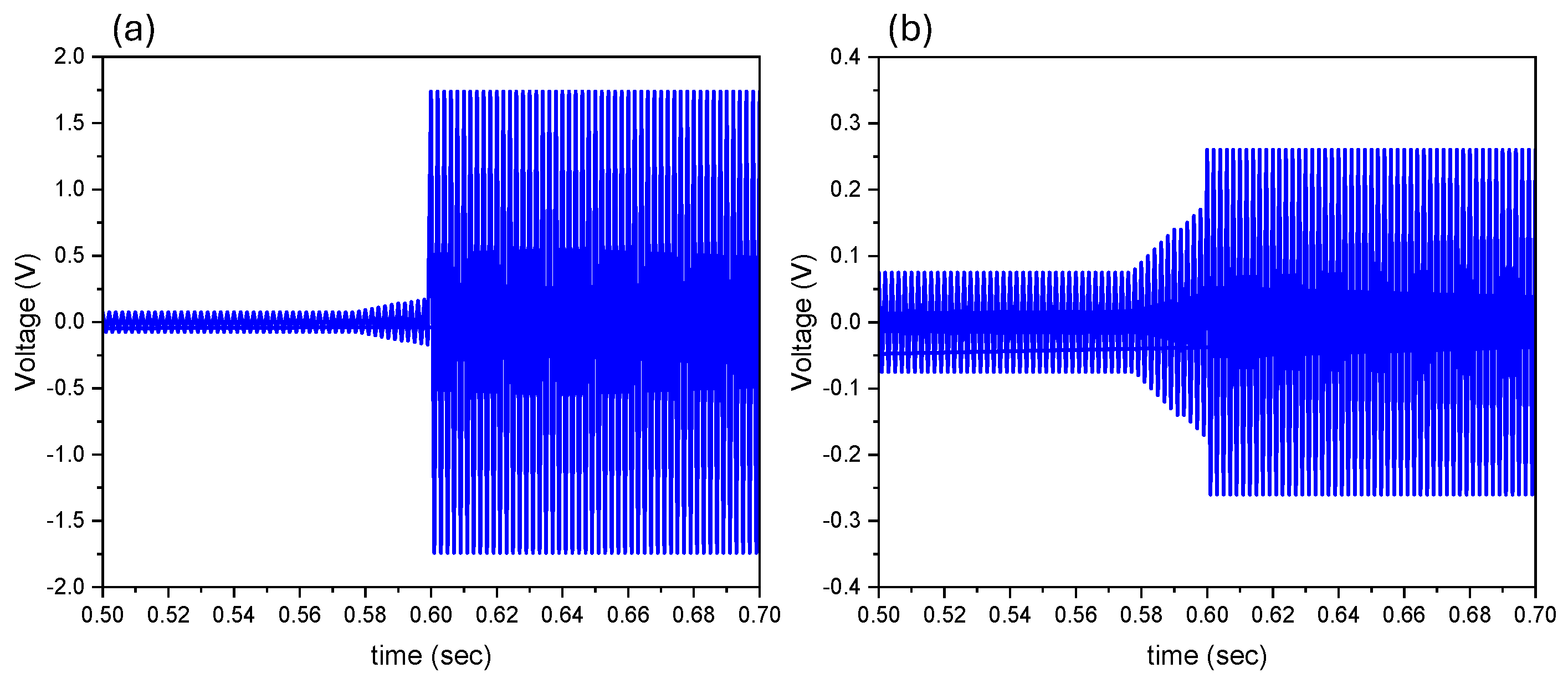
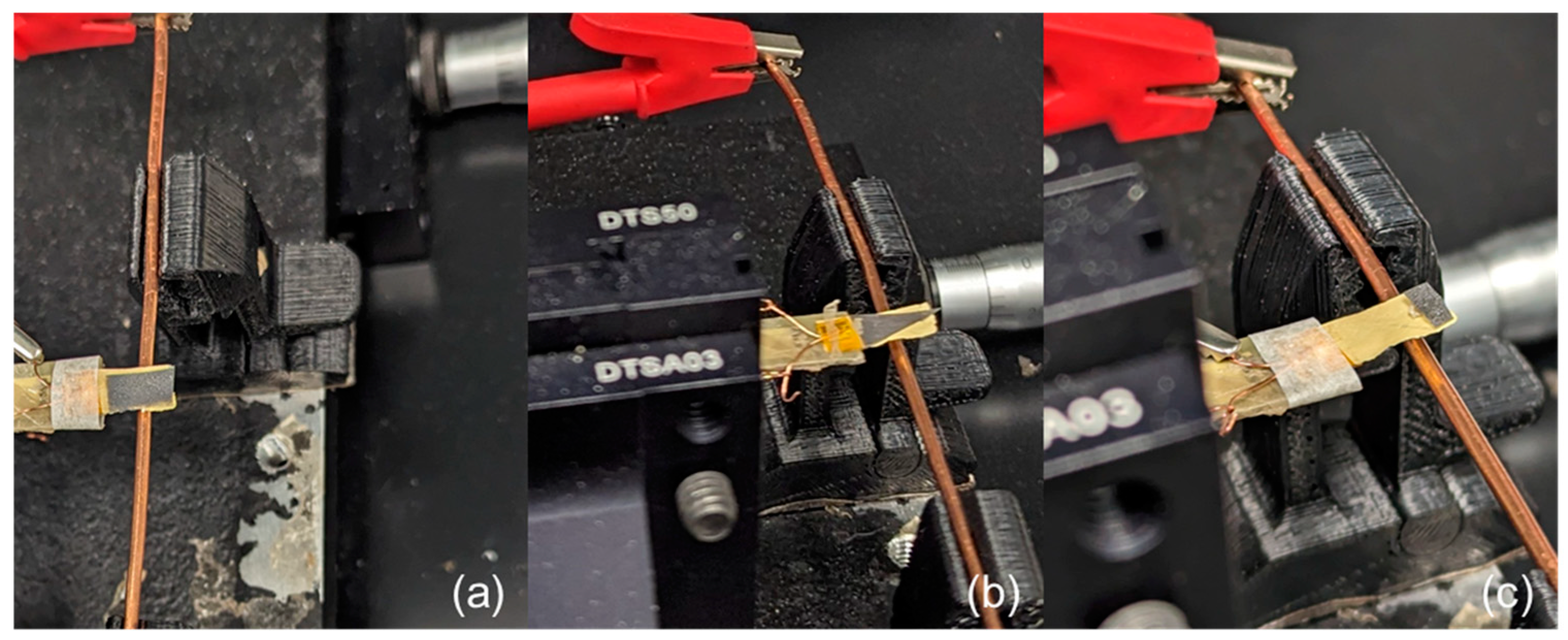
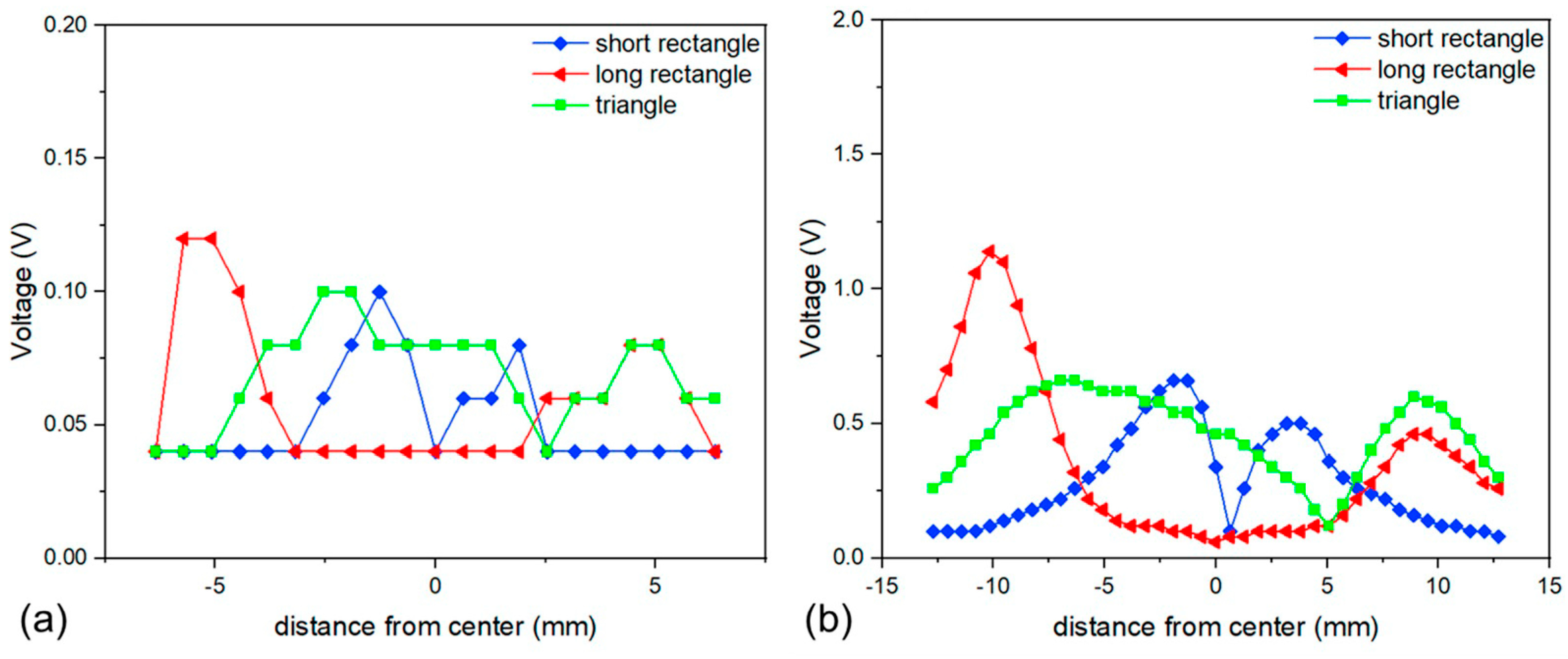

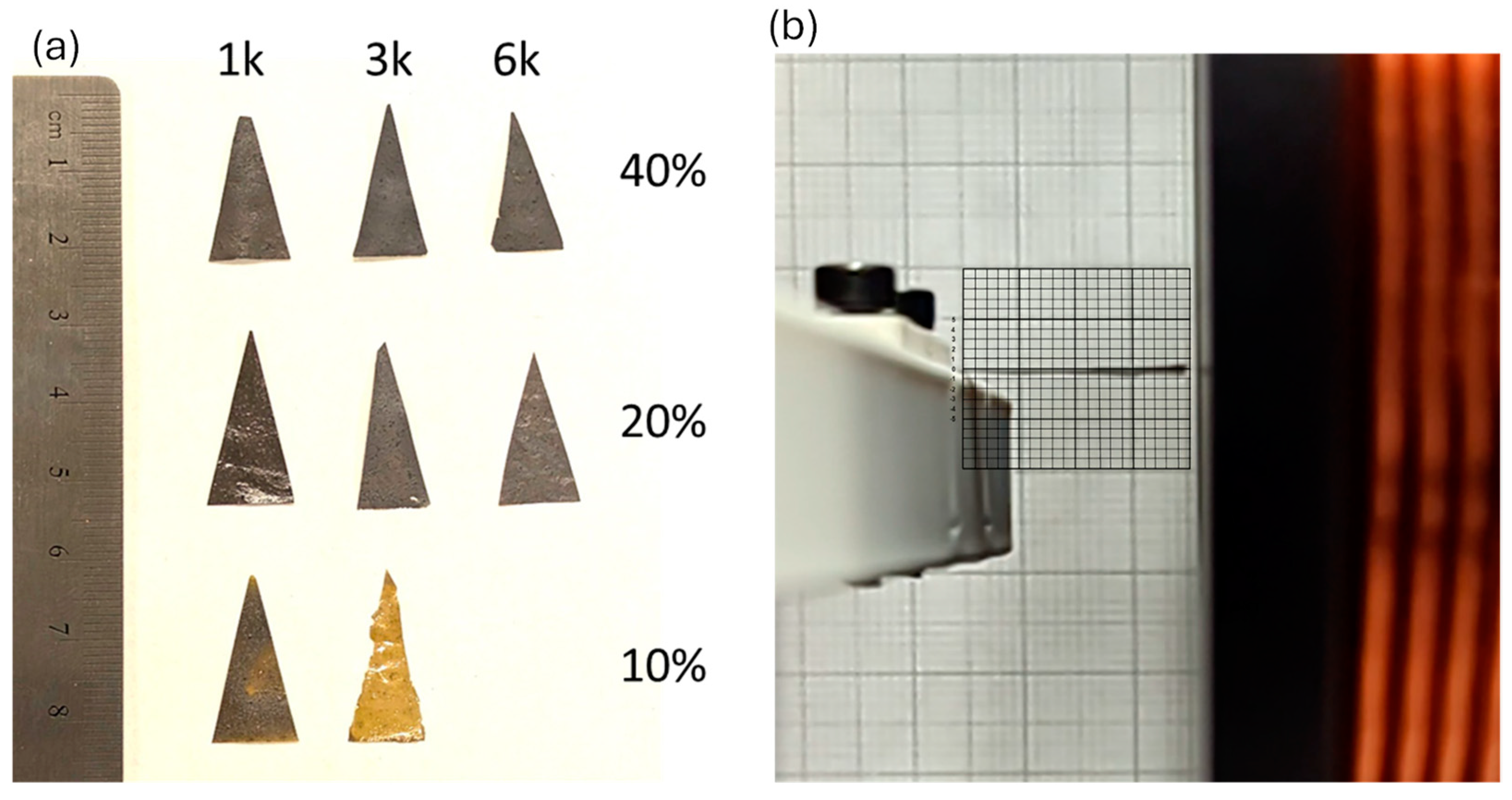
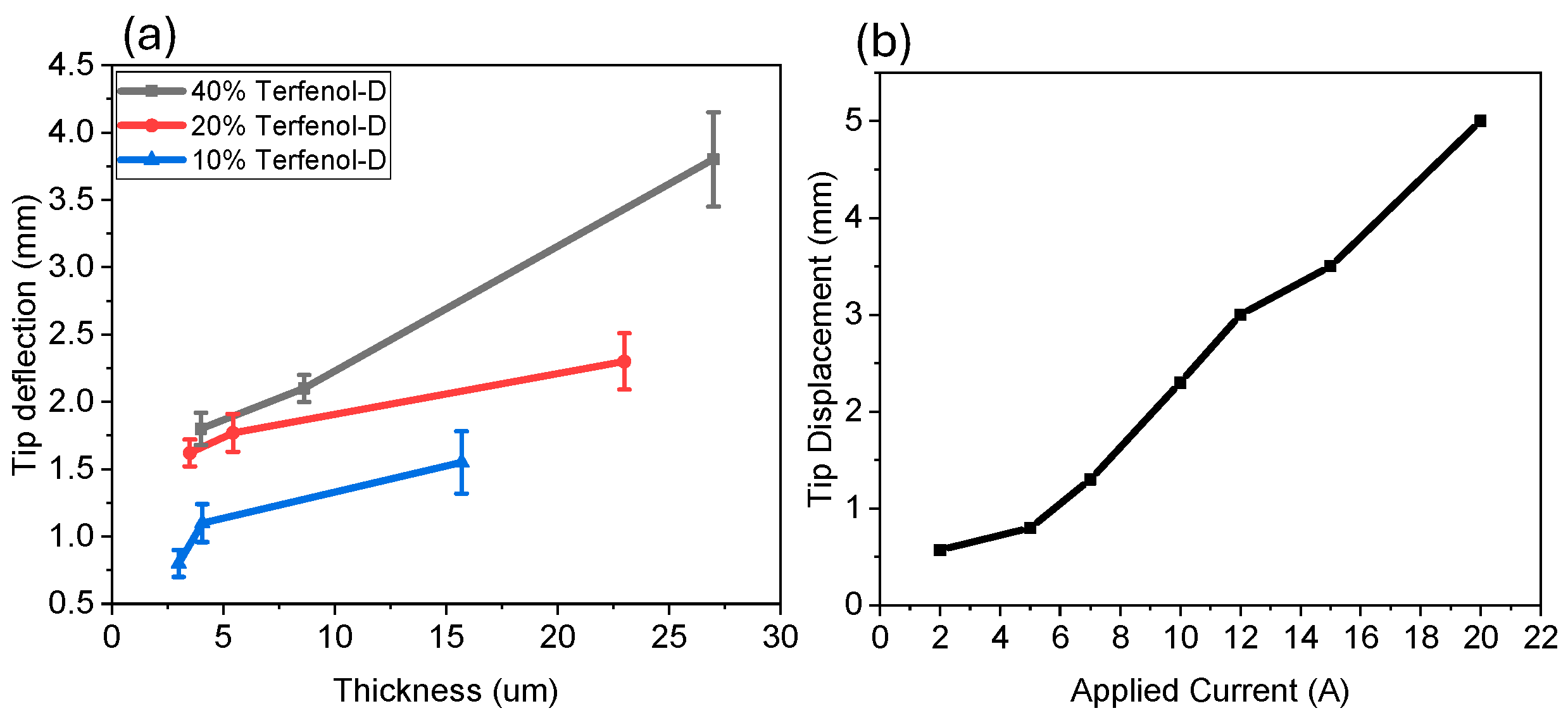

| Composite Composition | Triangle (T) | Long Rectangle (T) | Short Rectangle (T) |
|---|---|---|---|
| 60% NdFeB + 2611 1k | 0.45 | 0.442 | 0.48 |
| 60% NdFeB + 2611 0.5k | 0.492 | 0.473 | 0.789 |
| 70% NdFeB + 2611 1k | 0.53 | 0.489 | 0.651 |
| 70% NdFeB + 2611 0.5k | 0.838 | 0.727 | 0.91 |
Disclaimer/Publisher’s Note: The statements, opinions and data contained in all publications are solely those of the individual author(s) and contributor(s) and not of MDPI and/or the editor(s). MDPI and/or the editor(s) disclaim responsibility for any injury to people or property resulting from any ideas, methods, instructions or products referred to in the content. |
© 2024 by the authors. Licensee MDPI, Basel, Switzerland. This article is an open access article distributed under the terms and conditions of the Creative Commons Attribution (CC BY) license (https://creativecommons.org/licenses/by/4.0/).
Share and Cite
Guler, Z.; Jackson, N. A Polyimide Composite-Based Electromagnetic Cantilever Structure for Smart Grid Current Sensing. Micromachines 2024, 15, 1189. https://doi.org/10.3390/mi15101189
Guler Z, Jackson N. A Polyimide Composite-Based Electromagnetic Cantilever Structure for Smart Grid Current Sensing. Micromachines. 2024; 15(10):1189. https://doi.org/10.3390/mi15101189
Chicago/Turabian StyleGuler, Zeynel, and Nathan Jackson. 2024. "A Polyimide Composite-Based Electromagnetic Cantilever Structure for Smart Grid Current Sensing" Micromachines 15, no. 10: 1189. https://doi.org/10.3390/mi15101189







